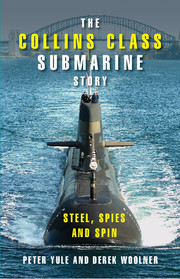Book contents
- Frontmatter
- Contents
- List of key people
- List of acronyms
- Introduction
- Part 1 You Can't Build Submarines in Australia
- Part 2 The Honeymoon Years 1987–92
- Part 3 ‘A Strange Sense of Unease” 1993–98
- Part 4 Resolution
- 22 ‘Hardly a day went by without the project getting a hammering in the press’: the project in crisis 1997–98
- 23 ‘Bayoneting the wounded’: the McIntosh-Prescott report
- 24 ‘That villain Briggs’ and the submarine ‘get-well’ program
- 25 ‘Inside the American tent’: the saga of the replacement combat system
- 26 ‘We'll do it and get rid of the buggers’: Kockums, ASC and Electric Boat
- 27 ‘We would find that challenging’: comparison and retrospect
- Notes
- Index
22 - ‘Hardly a day went by without the project getting a hammering in the press’: the project in crisis 1997–98
Published online by Cambridge University Press: 05 September 2013
- Frontmatter
- Contents
- List of key people
- List of acronyms
- Introduction
- Part 1 You Can't Build Submarines in Australia
- Part 2 The Honeymoon Years 1987–92
- Part 3 ‘A Strange Sense of Unease” 1993–98
- Part 4 Resolution
- 22 ‘Hardly a day went by without the project getting a hammering in the press’: the project in crisis 1997–98
- 23 ‘Bayoneting the wounded’: the McIntosh-Prescott report
- 24 ‘That villain Briggs’ and the submarine ‘get-well’ program
- 25 ‘Inside the American tent’: the saga of the replacement combat system
- 26 ‘We'll do it and get rid of the buggers’: Kockums, ASC and Electric Boat
- 27 ‘We would find that challenging’: comparison and retrospect
- Notes
- Index
Summary
The year 1997 marked a turning point in the new submarine project. Up until then the problems of the submarines had been debated between the main parties involved – ASC, Rockwell, Kockums, the navy and the Defence Department – with an occasional burst of media criticism, but during that year a significant new factor was added when the politicians joined in the fray. The ‘strange sense of unease’ that hung over the project in the mid-1990s soon became a major crisis that destroyed many careers and even threatened the future of the submarines themselves.
By the end of June 1997 the first three submarines were ‘structurally complete’. Of the remaining three, Dechaineux was 94 per cent complete, Sheean 88 per cent, and Rankin 83 per cent. ASC and its major sub-contractors had been working on the project for 10 years, but now the end of the construction phase was clearly in sight. Barring orders for more submarines from either the Australian navy or a foreign navy, submarine construction would inevitably wind down and the future of ASC would depend on either reconstructing itself as a general shipbuilder and engineering contractor or securing its role in the long-term support and maintenance of the submarines.
Even though one of the strongest arguments for building the submarines in Australia had been that it would give the skills and knowledge needed to support the submarines throughout their life, the navy seems to have given remarkably little thought to putting this admirable theory into practice and the early arrangements for supporting the submarines were totally inadequate.
- Type
- Chapter
- Information
- The Collins Class Submarine StorySteel, Spies and Spin, pp. 257 - 273Publisher: Cambridge University PressPrint publication year: 2008



